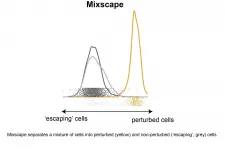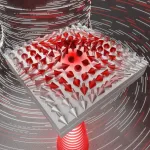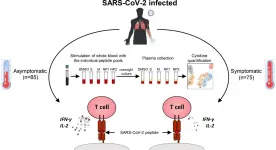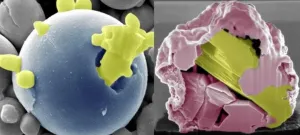Understanding the spatial and temporal dimensions of landscape dynamics
Heidelberg geoinformation scientists develop new computer-based method to analyse topographic changes
2021-03-01
(Press-News.org) The Earth's surface is subject to continual changes that dynamically shape natural landscapes. Global phenomena like climate change play a role, as do short-term, local events of natural or human origin. The 3D Geospatial Data Processing (3DGeo) research group of Heidelberg University has developed a new analysis method to help improve our understanding of processes shaping the Earth's surface like those observed in coastal or high-mountain landscapes. Unlike conventional methods that usually compare two snapshots of the topography, the Heidelberg approach can determine - fully automatically and over long periods - when and where surface alterations occur and which type of associated changes they represent.
The method, known as spatiotemporal segmentation, was developed under the guidance of Prof. Dr Bernhard Hoefle, whose 3DGeo group is based at the Institute of Geography and the Interdisciplinary Center for Scientific Computing (IWR) of Heidelberg University. "By observing entire surface histories, our new computer-based method allows for more flexible approaches. Unlike with previous methods, we no longer have to specify which individual change processes we want to detect or the points in time the analysis should include," the geoinformation scientist states. "Instead, areas and entire time periods during which similar changes occur are identified fully automatically. The huge three-dimensional datasets from the automatic laser measurements in the landscape thereby reveal various types of changes that the direct comparison of only two measurement points does not."
Among other techniques, Prof. Hoefle's team uses terrestrial laser scanning (TLS) to measure mountain and coastal landscapes. It generates three-dimensional models of a landscape represented as billions of measurement points in so-called 3D point clouds. "Measurement systems are installed on site and capture the terrain in short, regular intervals over several months, thus generating three-dimensional time series," explains Katharina Anders, a PhD student in Bernhard Hoefle's research group and at the IWR of Heidelberg University. These 3D time series are special because they contain both the temporal and spatial - ergo 4D - properties of surface changes, which can then be reviewed as in a time-lapse video.
"Spatiotemporal segmentation allows us to differentiate in detail between various phenomena that conventional methods detect as a single event or sometimes not at all," states Katharina Anders. The Heidelberg geoinformation scientists applied their method to a 3D time series of a stretch of coast in the Netherlands, which was acquired hourly over five months by scientists of the Delft University of Technology. The data analysis of the entire observation period revealed more than 2,000 changes representing temporary accumulation or erosion of sand that occurred in different locations at varying magnitudes and across various time periods. In this case, the dynamic transport of sand recorded by the measurement system was caused by complex interactions of wind, waves, and human influence. As a result, several truckloads of sand were transported on average in an area of 100 square metres over a period of four weeks, without influence from major storm events.
Findings of such analyses provide the basis for further studies of specific phenomena or underlying processes. At the same time, the information obtained on the dynamic evolution of surfaces opens up new possibilities for parameterisation and hence adaptation of computer-based environmental models. "The method we developed therefore makes an overall contribution to improving our geographic understanding of natural landscape dynamics," adds Katharina Anders.
INFORMATION:
The results of the joint study with Delft University of Technology were published in the "ISPRS Journal of Photogrammetry and Remote Sensing".
Internet information:
3D Geospatial Data Processing Research Group - http://www.uni-heidelberg.de/3dgeo
Video "Auto3Dscapes" - http://www.uni-heidelberg.de/de/pm202119-videos
ELSE PRESS RELEASES FROM THIS DATE:
2021-03-01
A team of researchers from New York University and the New York Genome Center has developed a new computational tool to help understand the function and regulation of human genes. The results, published today in the journal Nature Genetics, demonstrate how to interpret experiments that combine the use of CRISPR to perturb genes along with multimodal single-cell sequencing technologies.
The article describes how the new approach, called mixscape, helped to identify a new molecular mechanism for the regulation of immune checkpoint proteins that govern the immune system's ability to identify and destroy cancer cells.
"Our approach will help scientists to connect ...
2021-03-01
The scientists have demonstrated how to structure light such that its polarization behaves like a collective of spins in a ferromagnet forming half-skyrmion (also known as merons). To achieve this the light was trapped in a thin liquid crystal layer between two nearly perfect mirrors. Skyrmions in general are found, e.g., as elementary excitations of magnetization in a two-dimensional ferromagnet but do not naturally appear in electromagnetic (light) fields.
One of the key concepts in physics, and science overall is the notion of a "field" which can describe the spatial distribution ...
2021-03-01
A joint research team co-led by City University of Hong Kong (CityU) has developed a new soft tactile sensor with skin-comparable characteristics. A robotic gripper with the sensor mounted at the fingertip could accomplish challenging tasks such as stably grasping fragile objects and threading a needle. Their research provided new insight into tactile sensor design and could contribute to various applications in the robotics field, such as smart prosthetics and human-robot interaction.
Dr Shen Yajing, Associate Professor at CityU's Department of Biomedical Engineering ...
2021-03-01
By analyzing blood samples from individuals infected with SARS-CoV-2, researchers in Singapore have begun to unpack the different responses by the body's T cells that determine whether or not an individual develops COVID-19. The study, published today in the Journal of Experimental Medicine (JEM), suggests that clearing the virus without developing symptoms requires T cells to mount an efficient immune response that produces a careful balance of pro- and anti-inflammatory molecules.
Many people infected with the SARS-CoV-2 virus do not develop any symptoms, and the infection ...
2021-03-01
UNIVERSITY PARK, Pa. -- The rate of suicide among post-9/11 military veterans has been rising for nearly a decade. While there are a number of factors associated with suicide, veterans have unique experiences that may contribute to them thinking about killing themselves.
"Compared to their civilian peers, veterans are more likely to report having experienced traumatic adverse childhood experiences (ACEs) such as physical and emotional abuse," stated Keith Aronson, associate director of the Clearinghouse for Military Family Readiness at Penn State and the Social Science Research Institute ...
2021-03-01
LAWRENCE -- A new study from University of Kansas journalism & mass communication researchers examines what influences people to be susceptible to false information about health and argues big tech companies have a responsibility to help prevent the spread of misleading and dangerous information.
Researchers shared a fake news story with more than 750 participants that claimed a deficiency of vitamin B17 could cause cancer. Researchers then measured if how the article was presented -- including author credentials, writing style and whether the article was labeled as "suspicious" or "unverified" -- affected how participants perceived its credibility and whether they would adhere to the article's recommendations or share it on social media. The findings showed that ...
2021-03-01
AMES, Iowa - Inspired by nature's work to build spiky structures in caves, engineers at Iowa State University have developed technology capable of recovering pure and precious metals from the alloys in our old phones and other electrical waste.
Using controlled applications of oxygen and relatively low temperatures, the engineers say they can dealloy a metal by slowly moving the most reactive components to the surface where they form stalagmite-like spikes of metal oxides.
That leaves the least-reactive components in a purified, liquid core surrounded by brittle metal-oxide spikes "to create a so-called 'ship-in-a-bottle structure,'" said Martin Thuo, the leader of the research project and an associate professor of materials science and ...
2021-03-01
A type of ultrasound scan can detect cancer tissue left behind after a brain tumour is removed more sensitively than surgeons, and could improve the outcome from operations, a new study suggests.
The new ultrasound technique, called shear wave elastography, could be used during brain surgery to detect residual cancerous tissue, allowing surgeons to remove as much as possible.
Researchers believe that the new type of scan, which is much faster to carry out and more affordable than 'gold standard' MRI scans, has the potential to reduce a patient's risk of relapse by cutting the chances that a tumour will grow ...
2021-03-01
The amount of green space surrounding children's homes could be important for their risk of developing ADHD. This is shown by new research results from iPSYCH.
A team of researchers from Aarhus University has studied how green space around the residence affects the risk of children and adolescents being diagnosed with ADHD. And the researchers find an association.
"Our findings show that children who have been exposed to less green surroundings in their residential area in early childhood, which we define as lasting up until age five, have an increased risk of receiving an ADHD diagnosis when compared to children who have been surrounded by the highest level of green space," says ...
2021-03-01
Anorexia nervosa, bulimia nervosa and binge-eating disorder are the three main eating disorders that 4 out of in 10 individuals living in Western Europe will experience at some point in their lives. In recent years, studies on the genetic basis of anorexia nervosa have highlighted the existence of predisposing genetic markers, which are shared with other psychiatric disorders. By analysing the genome of tens of thousands of British people, a team from the University of Geneva (UNIGE), the University Hospitals of Geneva (HUG), King's College London, the University College London, the University of North Carolina (UNC) and The Icahn ...
LAST 30 PRESS RELEASES:
[Press-News.org] Understanding the spatial and temporal dimensions of landscape dynamics
Heidelberg geoinformation scientists develop new computer-based method to analyse topographic changes



